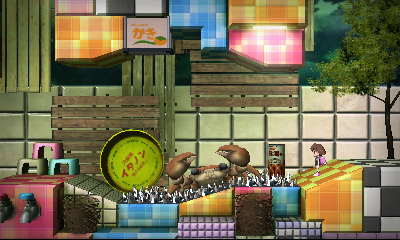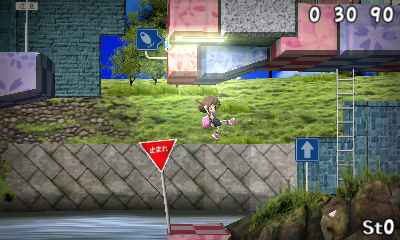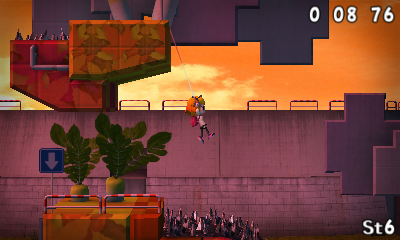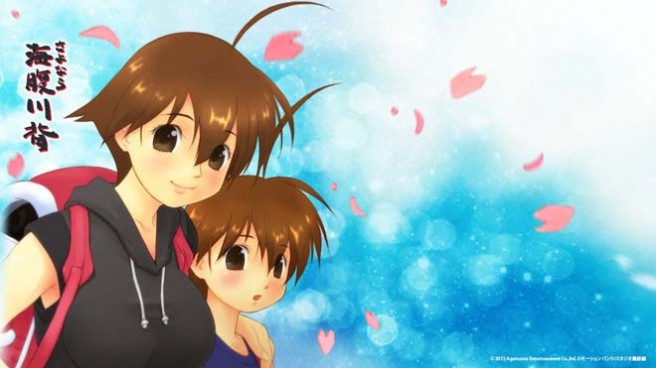[Review] Sayonara Umihara Kawase
System: Nintendo 3DS eShop
Release Date: April 24, 2014 (EU)
Developer: Agatsuma Entertainment
Publisher: Agatsuma Entertainment/Natsume
Author: Patrick
Sayonara Umihara Kawase’s title might suggest a farewell to this series, but for most players it’s more like a welcome to this bizarre world full of freakish fish and perilous platforming. While the first two Umihara Kawase games never left Japan, they managed to become cult classics thanks to their mix of unforgiving but addictive gameplay and some good old-fashioned weirdness. As a return to the series’ distinctive tone and action, Sayonara Umihara Kawase initially seems geared to hardcore fans, but it also manages to serve as a more gentle introduction to its unique style of platforming —before throwing players into the deep end of a pool full of acid.
As far as I’m aware there aren’t any major differences between the European version, which I played, and the Natsume-published North American version. Well aside from the fact that it was re-titled to “Umi’s Odd Odyssey”, because Natsume just have to alter the name of everything they localize. Just be glad they didn’t call it Legend of the River King Gaiden or Spanky’s Quest.

At a fundamental level, Sayonara Umihara Kawase is almost identical to the Super Famicom original and its Playstation sequel. As an anime girl (and now sushi chef) wielding a fishing line, players must traverse a series of abstract platforms that allow for interesting challenges without the need for pesky things like “narrative” or “logic”. The game billed itself as the first “rubbering action” game, which is a strange way of stressing the way that Kawase’s fishing line comes into play when exploring levels. Kawase might only be able to pull off a short hop, but by latching her lure onto walls and manipulating the line’s tension she can swing from the ceiling, grapple to higher ground and launch herself through the air. Sayonara Umihara Kawase preserves this central mechanic and for good reason; while it’s tricky to master the game’s unique physics system, getting around via fishing line is a whole lot of fun.
However, Sayonara Umihara Kawase doesn’t completely mirror its predecessors. For starters, the levels are structured differently and with this comes a new design philosophy. Previously the game had to be played through in one sitting. There were no saves or continues, but plenty of branching paths, with several stages featuring multiple exits. Because playing for too long resulted in the game cutting to the credits, seeking out hidden paths to skip stages and get further was necessary. Sayonara Umihara Kawase retains this playstyle (though not the timer, as far as I can tell), but it’s as a special “survival” mode unlocked by finding one of the game’s six endings. For the most part Sayonara Umihara Kawase follows a more contemporary structure with a level select screen. Because of this, it’s easier to see where the many branching paths lead or challenge different levels without having to replay the dull early stages. Ultimately it’s a design decision that helps to make the game feel more accessible, both in the sense that it’s quick to jump into the game and pick out a level and that it’s simpler for newcomers to progress without all that frustrating repetition.

Kawase’s fishing trips tend to be solitary outings, but this time around she’s joined by her younger self, a blonde Norwegian girl and a time-travelling policewoman. These new characters don’t exactly mix up the core gameplay but, like the structural changes, they help to ease new players in with unique techniques like placing temporary checkpoints and slowing down time. These additions don’t trivialize any of Umihara Kawase’s challenges, however. If the game seems easier than other entries, it because there’s an increased focus on pure platforming rather than dealing with the fishy foes that inhabit this bizarre world. Umihara Kawase’s enemies always struck me as the series’ weakness. Yes, those creepy fish with legs have a certain charm, but they also had an irritating tendency to randomly phase in and out of existence. Enemies appear far less frequently in Sayonara Umihara Kawase, and they don’t respawn anymore, so the game’s difficulty is based much more around skill than luck.
While Sayonara Umihara Kawase might be the most accessible game in the series, it’s still brutally difficult. It doesn’t feel as cheap as earlier entries, but there are plenty of spike pits, ridiculous jumps and giant bosses that actually change up their attack patterns now. The fact that the game even saves how many times you’ve failed a stage makes Sayonara Umihara Kawase feel a bit mean-spirited (who wants to play a game that constantly reminds you how awful you are at it?), but it’s not too cruel. Free from the previous games’ restrictive time limit, players can take it slow and practice their swinging and springing. Hit a wall? Just use the level select to try and find a different path through. That said, there’s plenty there for those who want to rush through the game. The other two Umihara entries proved to be quite popular with speedrunners, and the introduction of online leaderboards makes finding the shortest path through each level (or the entire game) a more competitive experience.

It’s difficult to explain just how Umihara Kawase succeeds as a platformer. The core mechanic of using a fishing line to grapple around stages goes against conventional level design, allowing skilled players to essentially travel anywhere. Successfully manipulating your momentum takes a lot of practice, but the simple, responsive (and customizable!) controls make the movement feel natural. I think why Umihara works is because of just how empowering it feels when this weird manner of traversing levels finally clicks. When most games try to empower players they hand them a gun or some kind of invincibility powerup, but Sayonara Umihara Kawase just tosses them a fishing line and a few tutorials and asks them to figure out the rest themselves. There is a bit of prodding along the way; that collectible backpack sitting just out of reach urges players to take risks in exploring their surroundings and using the fishing line in creative ways, but it’s done in a way that feels natural and rewarding. But perhaps the greatest reward comes from the feeling you get when you have complete mastery of the game’s physics and can swing anywhere like some kind of Japanese Spiderman. And then you fall into a pit of spikes again.

Yes, Sayonara Umihara Kawase is an ugly game. The charming sprites are gone, replaced by a cast of hideous 3D models. But the Umihara Kawase games were never known for their good looks, and as ugly as the graphics are they still retain the game’s surreal aesthetic. The frankly gross texture of the sea life and the surprising amount of detail in the abstract locations possess a strange charm that suits the game, even though it’s hardly visually appealing. It doesn’t work well with 3D turned on though, and doing so absolutely destroys the framerate. Sayonara Umihara Kawase also continues the series’ trend of having an absolutely atrocious user interface, with useful functions like switching characters and viewing replays tucked away behind misleading menus. But these are all minor problems and the core of Umihara Kawase —that unique, challenging form of fishing-based platforming— is as solid as ever.

I fully expect that most people will see the game’s price tag and turn up their nose. There’s enough content here to justify the price, but the vast majority of players won’t stick with
Umihara Kawase long enough to enjoy the thrill which comes with mastery over a truly unique sense of physics. That or they’ll turn up their nose at the anime girls and weird title. But those willing to stick with the game and all its quirks will discover one of the most unique and enjoyable platformers on the 3DS. While Sayonara Umihara Kawase attempts to provide a more approachable experience, it doesn’t compromise what made the series work in the first place. I’m hesitant to call Sayonara the best entry in the series, but it’s clear that the team at Agatsuma have captured what made this quirky platformer stand out from the crowd.
